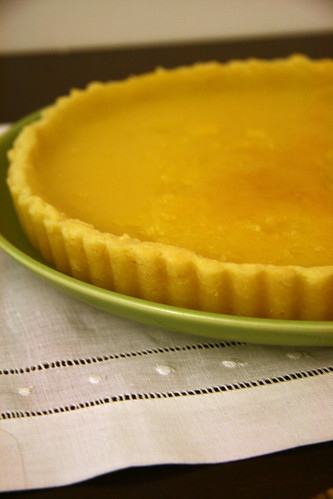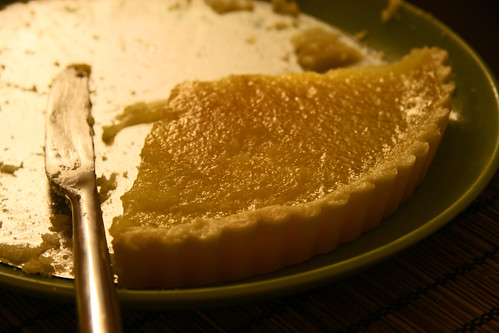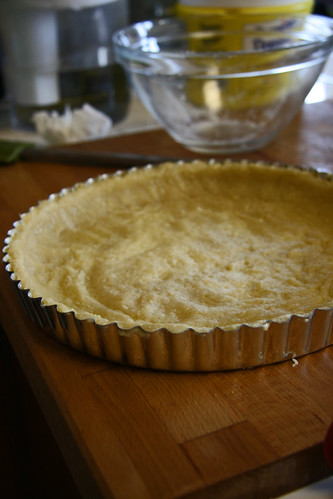 Yes, it's getting colder and yes, it's getting darker. I fully expect the snow to come down any minute and I fully expect to not see the sun again until April - March, if we're lucky. Last week, however, in a last-minute fit of denial, I decided to make the summeriest, most cheerful dessert I could think of: a lemon tart.
Yes, it's getting colder and yes, it's getting darker. I fully expect the snow to come down any minute and I fully expect to not see the sun again until April - March, if we're lucky. Last week, however, in a last-minute fit of denial, I decided to make the summeriest, most cheerful dessert I could think of: a lemon tart.What you should know: I have a passionate love of desserts that involve lemons. On trips to southern France and the Amalfi coast in Italy, I made it a point to eat at least one, preferably two or three lemon desserts or pastries every day. There was one particular lemon tart that I ate in Nice that has stuck in my memory for lo, these many years. The tangy lemony-ness and the smooth, silky texture of the filling, the flaky, yet tender crust, the sweet note that lingered after the sour had passed - just thinking about it takes me right back.
 That taste - the 7th grade poet in me would call it the taste of sunshine - is what I had a longing for. I have been sitting on a lemon tart recipe for a long time, waiting for a rainy day (I didn't intend to wait for a literal rainy day, but that's how it worked out). This one comes from a genuine Parisienne who spent a year at my lovely alma mater, and with whom one of my dearest friends and most loyal readers is still in close contact. The text of this recipe is written in somewhat eccentric English and has very little in the way of concrete instruction, but luckily my mom (my CIA-trained, kitchen-ruling mom) was on hand to help fill in the blanks, as it was the very first tart I've ever made.
That taste - the 7th grade poet in me would call it the taste of sunshine - is what I had a longing for. I have been sitting on a lemon tart recipe for a long time, waiting for a rainy day (I didn't intend to wait for a literal rainy day, but that's how it worked out). This one comes from a genuine Parisienne who spent a year at my lovely alma mater, and with whom one of my dearest friends and most loyal readers is still in close contact. The text of this recipe is written in somewhat eccentric English and has very little in the way of concrete instruction, but luckily my mom (my CIA-trained, kitchen-ruling mom) was on hand to help fill in the blanks, as it was the very first tart I've ever made.The result? It was stunning. Every bite embodied that sunshiny, liquid-light, tart-yet-sweet, creamy, silky perfection I've been dreaming about since that very first day in Nice what - six years ago? (Actually, I think this tart might have been better than that tart, but nostalgia does gild that memory a bit.) No, it didn't stave off the cold, the rain, the coming three-months darkness. But it did make being alive on that one day a little more worthwhile.
 The Famous Fanélie's Lemon Tart
The Famous Fanélie's Lemon Tart*I've adapted the recipe rather heavily and will mark my additions and changes with asterisks.
For the tart shell:

- 150 g flour
- 125 g butter
- 50 g sugar
- *dash salt
- The original recipe called for the ingredients to be mixed by hand. *Being lazy and inclined to repetitive stress injury, I took the easy way out and used a food processor. This necessitated the addition of a couple of tablespoons of water to bring the dough together. In the future, I would not do this, as I'm afraid that step caused my crust to shrink almost beyond rescue.
- After the dough is smooth and homogeneous, put it in the fridge for a half an hour.
- Then, press it into a tart pan with a removable bottom.
- Put it in the freezer for at least ten minutes.
For the lemon curd: (I've doubled this recipe, as we were afraid - and rightly so - that the original would not fill my tart shell.)
- 2 eggs, beaten
- 300 g of sugar
- the juice and zest of two lemons
- 120 g of butter
- *pinch salt
- *The original recipe called for a pan over direct heat, but given my propensity for burning everything, my mom's suggestion to use a double-boiler (in our case, a tempered-glass bowl positioned on top of a saucepan of simmering water) sounded like a very, very good idea.
- Melt the butter in the top bowl, very slowly.
- When the butter is melted, keep the pan on the fire, but on low. Add the lemon juice and zest, sugar, and salt.
- Mix the ingredients very slowly, with circular motions until the mixture is fully combined and the sugar melting.
- Add the egg very slowly and stir constantly, but slowly.
- Continue cooking the curd on low/medium-low heat until it thickens up and turns whitish and less transparent.
- *While preparing the curd, remove the tart shell from the freezer and partially bake the shell (between five and ten minutes).
- When the curd is "à point" (anyone have a good translation for this?), pour it into the pastry shell and bake the tart at 375 for about 15 minutes. The shell will hopefully brown a bit and the top of the curd may brown and begin to bubble.
- If you can, wait until it's cooled to serve. Be very careful, and you'll get gorgeous slices of semi-transparent neon yellow on crumby, flaky, cream-colored crust.



5 comments:
jeez, all that adapting and you couldn't even convert out of metric for us ignorant Americans? :-)
My mom always adds a couple tablespoons of ice water to the dough in her food processor when she's making pie crust. She doesn't usually have crust-shrinkage problems with this method. I have heard you can use white wine as well, but I have not yet tried this.
G. fox: Sorry about the metrics - I used my fancy-dancey kitchen scales that can take metric.
Liz: Yeah, doesn't usually happen with my pie crust either - I think it's because of the high butter:flour ratio in this particular recipe. Also the relatively high amount of sugar - when that melts, it's all over. Luckily, after blind baking we could still squish the sides back to where they belonged with no damage done.
this looks amazing! I'm going to have to try this recipe out when the wind is blowing hard and there's a couple of inches of snow on the ground...
Looks very refreshing!
Post a Comment